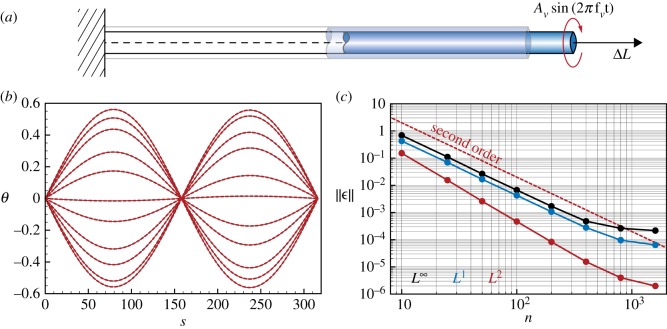Figure 16.
Time-space convergence study for twist forced vibrations in a stretched rod. (a) We consider a rod clamped at one end, forced to vibrate by applying the periodic couple to the free end, and characterized by rest length which is extended to a final length . (b) Comparison between analytical θ (black lines) and numerical θn (red dashed lines) angular displacement with respect to the reference configuration along a stretched rod. Each red (numerical simulation) and black (analytical solution) line corresponds to the angular displacement along a rod discretized with n=1600 elements, and sampled at regular intervals Δt=Tv/10 within one loading period . (c) Norms (black), L1(ϵ) (blue) and L2(ϵ) (red) of the error ϵ=∥θ−θn∥ at different levels of time-space resolution are plotted against the number of discretization elements n. Here, the time discretization δt is slaved by the spatial discretization n according to δt=10−4δl seconds. For all studies, we used the following settings: rod’s density ρ=10 kg m−3, Young’s modulus E=106 Pa, shear modulus G=2E/3 Pa, shear/stretch matrix , bend/twist matrix , forcing amplitude Av=103 Nm, forcing frequency fv=1 s−1, dilatation factor e=1.05, rest length , rest radius , simulation time Tsim=2000 s. We enabled dissipation in the early stages of the simulations, letting γ decay exponentially in time to a zero value.

